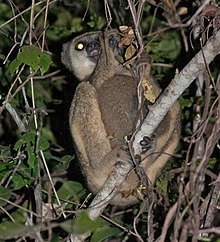Woolly lemur
The woolly lemurs, also known as avahis or woolly indris, are nine species of strepsirrhine primates in the genus Avahi. Like all other lemurs, they live only on the island of Madagascar.
| Woolly lemurs (Avahi) | |
|---|---|
 | |
| Western woolly lemur (A. occidentalis) | |
| Scientific classification | |
| Kingdom: | Animalia |
| Phylum: | Chordata |
| Class: | Mammalia |
| Order: | Primates |
| Suborder: | Strepsirrhini |
| Family: | Indriidae |
| Genus: | Avahi Jourdan, 1834[1] |
| Type species | |
| Lemur laniger Gmelin, 1788 | |
| Diversity | |
| About 9 species | |
 | |
| Combined distribution of Avahi[2] | |
| Synonyms[1][3] | |
| |
With a body size of 30 to 50 cm and a weight of 600 to 1200 g, the woolly lemurs are the smallest indriids. Their fur is short and woolly.[4] The body can be grey brown to reddish, with white on the back of the thighs,[5] with a long, orange tail. The head is round with a short muzzle and ears hidden in the fur.
Woolly lemurs can be found in both humid and dry forests, spending most of their time in the leafy copse. Like many leafeaters, they need long naps to digest their food. Woolly lemurs live together in groups of two to five animals, which often consist of parents and several generations of their offspring.[6]
Like all indriids, the woolly lemurs are strictly herbivorous, eating predominantly leaves, but also buds and, rarely, flowers.
Males and females live in pairs. Although likely, the presence of extrapair copulations (which exist in other pair-living nocturnal lemurs, e.g. the Masoala fork-marked lemur (Phaner furcifer)[7] and the fat-tailed dwarf lemur (Cheirogaleus medius)[8]) has never been demonstrated in Avahi species. The gestation period is four to five months, with births usually coming in September. In the first few months, the young rides on the back of its mother. After about six months, it is weaned, and can live independently after a year, although it will typically live for another year in proximity to its mother. Overall life expectancy is not known.
On November 11, 2005, a research team that discovered a new species of woolly lemur in 1990 in western Madagascar named the species, Bemaraha woolly lemur (Avahi cleesei), after actor John Cleese, in recognition of Cleese's work to save lemurs in the wild.[9] In 2006, a taxonomic revision of eastern avahis based on genetic and morphological analyses led to the identification of two extra species: A. meridionalis and A. peyrierasi.[10] Further taxonomic revision increased the number of species, by adding A. ramanantsoavana and A. betsileo.[11] Finally a new species was discovered in the Masoala peninsula, Moore's woolly lemur (A. mooreorum).[12]
Classification
Nine species are currently recognized:[13]
- Eastern woolly lemur, Avahi laniger
- Western woolly lemur, Avahi occidentalis
- Sambirano woolly lemur, Avahi unicolor
- Bemaraha woolly lemur, Avahi cleesei
- Peyrieras's woolly lemur, Avahi peyrierasi
- Southern woolly lemur, Avahi meridionalis
- Ramanantsoavana's woolly lemur, Avahi ramanantsoavani
- Betsileo woolly lemur, Avahi betsileo
- Moore's woolly lemur, Avahi mooreorum
References
- Groves, C. P. (2005). Wilson, D. E.; Reeder, D. M. (eds.). Mammal Species of the World: A Taxonomic and Geographic Reference (3rd ed.). Baltimore: Johns Hopkins University Press. p. 119. ISBN 0-801-88221-4. OCLC 62265494.
- "IUCN 2014". IUCN Red List of Threatened Species. Version 2014.3. International Union for Conservation of Nature. 2012. Archived from the original on June 27, 2014. Retrieved 12 March 2015.
- McKenna, MC; Bell, SK (1997). Classification of Mammals: Above the Species Level. Columbia University Press. p. 336. ISBN 0-231-11013-8.
- Tattersall, Ian (1982). Columbia University Press (ed.). The Primates of Madagascar. New York.
- Rowe, Noel (1996). The Pictorial Guide to the Living Primates. pp. 47.
- Ganzhorn, J.U.; Abraham, J.P. & Razananhoera-Rakotomalala, M. (1985). "Some aspects of the natural history and food selection of Avahi laniger". Primates. 26 (4): 452–463. doi:10.1007/BF02382459.
- Schülke, O; Kappeler, PM & Zischler, H (2004). "Small testes size despite high extra-pair paternity in the pair-living nocturnal primate Phaner furcifer". Behavioral Ecology and Sociobiology. 55 (3): 296–310. doi:10.1007/s00265-003-0709-x.
- Fietz J, Zischler H, Schwiegk C, Tomiuk J, Dausmann KH, Ganzhorn JU (2000). "High rates of extra-pair young in the pair-living fat-tailed dwarf lemur, Cheirogaleus medius". Behavioral Ecology and Sociobiology. 49: 8–17. doi:10.1007/s002650000269.
- Thalmann, U. & T. Geissmann (2005). "New species of woolly lemur Avahi (Primates: Lemuriformes) in Bemaraha (Central Western Madagascar)". American Journal of Primatology. 67 (3): 371–376. doi:10.1002/ajp.20191. PMID 16287101.
- Zaramody A.; Fausser J.-L.; Roos C.; Zinner D.; Andriaholinirina N.; Rabarivola C.; Norscia I.; Tattersall I. & Rumpler Y. (2006). "Molecular phylogeny and taxonomic revision of the eastern woolly lemur (Avahi laniger)". Primate Report. 74: 9–22.
- Andriantompohavana R.; Lei R.; Zaonarivelo J. R.; Engberg S. E.; Nalanirina G.; McGuire S. M.; Shore G. D.; Andrianasolo J.; Herrington K.; Brenneman R. A. & Louis E. E. Jr (2007). "Molecular phylogeny and taxonomic revision of the woolly lemurs, Genus Avahi (Primates: Lemuriformes)" (PDF). Special Publications of the Museum of Texas Tech University. 51: 1–64.
- Lei R.; Engberg S.E.; Andriantompohavana R.; McGuire S.M.; Mittermeier R.A.; Zaonarivelo J.R.; Brenneman R.A. & Louis E.E. Jr (2008). "Nocturnal Lemur Diversity at Masoala National Park" (PDF). Special Publications of the Museum of Texas Tech University. 53: 1–48.
- Mittermeier, R. A.; et al. (2008). "Lemur Diversity in Madagascar". International Journal of Primatology. 29 (6): 1607–1656. doi:10.1007/s10764-008-9317-y. hdl:10161/6237.
External links
| Wikispecies has information related to Woolly lemur |
- Image of female and young
- Primate Info Net Avahi Factsheets
- Chisholm, Hugh, ed. (1911). . Encyclopædia Britannica (11th ed.). Cambridge University Press.